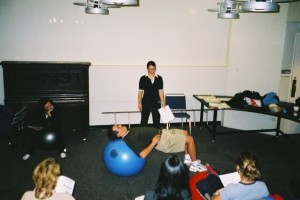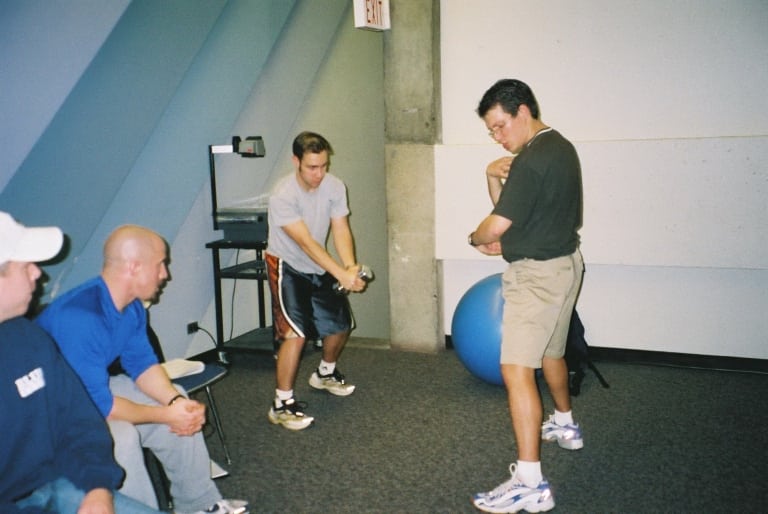
I received another email asking how to start teaching fitness education courses.
I am guessing it is a sign that I need to do a blog post on it.
So let’s give this a go.
Where it All Started.
 Way back in 1997, I graduated from university. I got my Bachelor’s Degree in Kinesiology from Simon Fraser University.
Way back in 1997, I graduated from university. I got my Bachelor’s Degree in Kinesiology from Simon Fraser University.
While working in a physical therapy clinic, I realized that I had not learned much about practical skills while in school. I learned quite a lot about anatomy, biomechanics, physiology, etc. But I did not know much like this: you have this injury or problem, so do this exercise.
I learned a lot about the exercise side of things on the job from the physical therapists I worked with, other Kinesiologists, and my research.
My boss then saw all of the work I was doing and asked if I wanted to do an in-service for the physical therapy clinic. I said, “Sure,” and gave it a go.
Fitness Presentations
I worked on a presentation about exercises with the stability ball for clients with injuries.
Presenting in front of all the physical therapists worried me. I wasn’t sure if I would be able to answer their questions. I worried if they would like what I had to present or if they would care about what I had to offer.
My worries were wasted, as the in-service went well and was well-received by all.
I enjoyed the research, turning the research into practice, and the teaching side of things.
Since I already had the first presentation done, I contacted the university I graduated from and asked if they would like me to present a two-hour course to the Kinesiology students at Simon Fraser University.
The university liked the idea, and so did the students. We set aside an evening, and I presented the same course I had given at the physical therapy clinic.
The students had fun. I had fun. I enjoyed presenting and wanted to find out how I could do more.
That led to all my courses and then to the creation of Exercises For Injuries.
I think I now have 14 main courses focusing on exercises and injuries. I can’t remember how many classes I have taught and how many fitness professionals have attended, but I still look forward to each presentation.
It’s funny to look back at the two pictures above. In the one at the very top, you can see me demonstrating some exercises to the students. You can see me chatting about the shoulder in the one just above this. Even way back then, I was excited about the shoulder.
Let me share some tips with you on how to get started teaching fitness education courses.
#1 – What Is Your Specialization?
It would be best if you focused on something. As you know, mine is exercise and injuries. There was a time when I lost focus and started doing all kinds of fitness education courses. Doing everything will spread you too thin and make it difficult for people to know what you are best in.
It would help if you found out what your specialization is.
You can do this by:
- Looking at the clients that you love working with.
- Figuring out what aspect of fitness excites you most.
- Deciding what part of fitness you want to be the leader in.
After you have done this, it will be easier for you to determine who you can approach to help.
#2 – Do Some In-services
Now that you have your specialization, you can ask some fitness centers, physical therapy clinics, or recreation centers if they would be interested in an in-service in your field.
Let’s say you love dumbbell training. You like thinking of different and unique ways to use dumbbells to exercise with. You find most people use dumbells for boring bodybuilding exercises. Still, you have developed methods for using dumbbells that are exciting, fun, unique, different, and which lead to faster results.
You can approach a fitness center and ask if you could talk to the person in charge of staff education. When you meet them, introduce yourself, let them know your specialization, share your idea with them, and ask if you could do a free in-service for their staff one evening. Most fitness center managers are always looking for fun and exciting things for their team – significantly if it does not cost them anything.
Yes, at the start, you will have to do things for free or for a small honorarium.
Doing a few in-services at no charge will give you practice in presenting, give you a chance to test things out, and allow you to get feedback from people so that you can improve.
If I were to do it over again, this is how I would start.
From this point, you can have your weekend courses or present at conferences.
Let me know if you want me to discuss the next step in presenting fitness education courses.
Rick Kaselj, MS
P.S. – If you want to check out the fitness education courses that I present:


